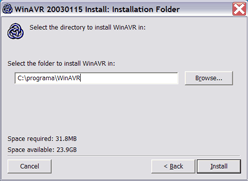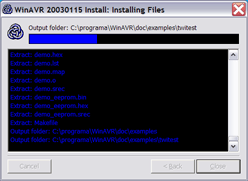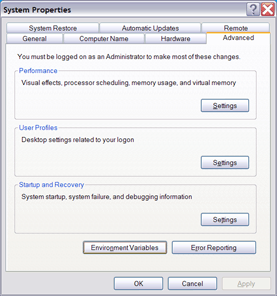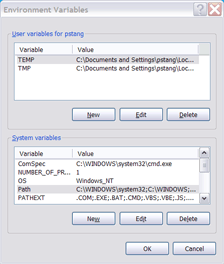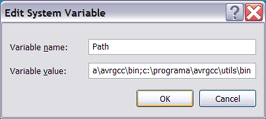Installing AVR-GCC
Sections
- Overview
- Downloading
- Installing
- Configuring
- Testing
Written by Pascal Stang | Updated:
Sat Jul 12, 2003
1. Overview
AVR-GCC is a free open-source C/C++ compiler for the Atmel AVR series processors.
AVR-GCC is actually not a unique product but rather a subset of the complete
GNU Compiler Collection (GCC) specially customized to work with AVR processors.
For more information about the complete GCC, see the Free Software Foundation's
(FSF) GCC Home Page.
TODO: Notes about command line interface, makefiles, hosts, targets, etc
2. Downloading
AVR-GCC is available from a huge number of sites and locations because it
is a free open-source program. You can download AVR-GCC in source-code form,
or a precompiled binary (program) already made to work on a certain kind of
host (OS/machine). Since many users of AVR processors are not familiar with
how to compile and set up GCC directly from the source code, more experienced
users have made installable packages to greatly simplify
the process.
Installation packages are available for the following hosts (operating systems)
supported by RSL:
- Windows (98,NT,ME,2000,XP)
- WinAVR is the best prepackaged windows AVR-GCC installation currently
available.
Download it from:
- Linux
- Linux installations are readily available but are not yet supported
by RSL
- MAC OSX
- AVR-GCC has been successfully compiled and run on OSX because of OSX's
Unix base, however, no pre-made installations are currently known.
3. Installing
Installing WinAVR
Before beginning the install process, you need to choose/create a location/directory
where the compiler and associated files can be installed. This directory should
be different from the one in which you intend to keep the code you write.
The directory you choose should not contain spaces in its name or path. Some
examples are:
c:\WinAVR (GOOD)
c:\programming\WinAVR (GOOD)
c:\Code\AVR\WinAVR (GOOD)
c:\Program Files\WinAVR (NOT RECOMMENDED - HAS SPACES IN PATH)
c:\My code\AVR\WinAVR (NOT RECOMMENDED - HAS SPACES IN PATH)
From the download step you should have a self-installing .exe file named
Winavr-20030115-bin-install.exe. It is unimportant where
this file is located. You can delete it if you wish after the installation
completes but you may want to keep it for later re-installs.
- Double-click the .exe file to begin installation.
- Click through license agreement
- Choose your installation folder
- Watch installation progress (should take 1-2 minutes depending on computer
speed)
- Readme.txt is opened automatically (installation is complete)
If you have some time, browse through the readme.txt. It contains a wealth
of information about GCC, WinAVR, important terminology, and links to AVR
projects and additional information.
4. Configuring
Following the Install step, AVR-GCC should be functional. However, like most
compilers, we need to add some environment variables to help make AVR-GCC
easier to access from the command-line.
- Configuring WinAVR under Windows 2000 and Windows XP
If you are running Windows 2000 or Windows XP, you will need to set the
following environment variables to enable you to use avr-gcc from any command-line
prompt. (These examples assume you installed WinAVR into the directory C:\WinAVR.
If you installed somewhere else, alter the statements accordingly)
set AVR to C:\WinAVR
to PATH add ;C:\WinAVR\bin;C:\WinAVR\utils\bin
To add these changes in Windows 2000/XP:
- Go to the Start menu and open the Control Panel.
- From the Control Panel, double-click System
(XP users may need to "Switch to Classic View")
- Select the Advanced tab and and click on the Environment
Variables button.
- You will need to do the following three things in this window:
- Under the System variables section, find the PATH
variable and click on Edit to open an Edit
System Variable box. You will need to add the following to
the end of the Variable Value field: ;C:\WinAVR\bin;C:\WinAVR\utils\bin.
Make sure that no extra spaces are added before the semicolon, and that
the semicolons correctly separate the entires before/after your edits.
When you are done, click on OK for the Edit
System Variable box.
- Next, click on the New button to add a new environment
variable. In the Variable Name field, enter the name
AVR, then in the Variable Value field
enter the value C:\WinAVR.
- That's it. Click the OK button to close the Environment
Variables window.
- Click the OK button to close the System Properties
window and apply the changes.
- Configuring WinAVR under Windows 98 and Windows ME
If you are running Windows 98, the WinAVR installer should have taken care
of the environment variables for you. You may need to reboot for the changes
to take effect. If you still have problems (such as make not being recognized
as a valid command or io.h not being found) you may need to make some additional
changes. You will need to add the following environment settings to your autoexec.bat
file. (Remember to replace C:\WinAVR with the actual path where you installed
WinAVR.)
set AVR=C:\WinAVR
set PATH=C:\WinAVR\bin;C:\WinAVR\utils\bin;%path%
You can cut and paste these to the end of your autoexec.bat file, but you
may need to make one small change first. Depending on your system, you may
have spaces in your path string (example: …;c:\Program Files\…)
and these spaces may cause this string to get parsed as two strings instead
of one. This problem should be fixable by placing quotes around %path% before
copying it into autoexec.bat:
set PATH=C:\WinAVR\bin;C:\WinAVR\utils\bin;”%path%”
Once this is done and autoexec.bat has been run, any command prompt should
be able to correctly call make.
5. Testing
There are a few simple steps you can take to verify that your WinAVR installation
is ready to be used:
- Open a Command Prompt (find it in your Start Menu or
select Run, and run cmd.exe)
- Type make at the prompt
- If windows reports 'make' is not recognized as an internal
or external command... then you have not set the PATH variable
correctly in the configuration step
- If windows reports make: *** No targets specified and no makefile
found. Stop. then the compiler is working and simply didn't
find any code to compile
- Change directories to C:\WinAVR\doc\examples\demo (type cd c:\WinAVR\doc\examples\demo)
- Type make clean at the prompt
- Type make
- If your output looked like this then you just compiled your first AVR
program:
C:\Programa\winavr\doc\examples\demo>make
avr-gcc -g -Wall -O2 -mmcu=at90s2313 -c -o demo.o demo.c
avr-gcc -g -Wall -O2 -mmcu=at90s2313 -Wl,-Map,demo.map -o demo.elf demo.o
avr-objdump -h -S demo.elf > demo.lst
avr-objcopy -j .text -j .data -O ihex demo.elf demo.hex
avr-objcopy -j .text -j .data -O binary demo.elf demo.bin
avr-objcopy -j .text -j .data -O srec demo.elf demo.srec
avr-objcopy -j .eeprom --change-section-lma .eeprom=0 -O ihex demo.elf demo_eeprom.hex
avr-objcopy -j .eeprom --change-section-lma .eeprom=0 -O binary demo.elf demo_eeprom.bin
avr-objcopy -j .eeprom --change-section-lma .eeprom=0 -O srec demo.elf demo_eeprom.srec
C:\Programa\winavr\doc\examples\demo>
Written by Pascal Stang | Updated:
Sat Jul 12, 2003
